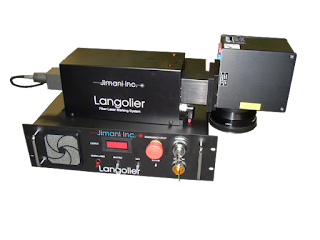In manufacturing, items
made of metal often require engraving or markings for proper identification. Before
the development of a commercial laser
marking system, this identification process was
usually achieved with labels, stamping, machine engraving, acid etching or ink
printing. Then, in the mid-70s, advances in technology made it possible to
create these markings using a focused beam of laser light.Before long, rapid
refinements resulted in lasers that could be used with such accuracy that they
could engrave not only letters and numbers, but even graphical images like
company logos. Next came the ability to etch readable data such as barcodes and alignment
marks or rulers, often critical components in manufacturing. It was hardly a
surprise, then, when fiber laser marking machines gained a foothold in
those instances when laser marking provided a clear financial and/or quality
advantage over increasingly outdated methods of engraving and marking.
For decades, the only
practical way to produce the 1.06 micron laser light (the precise wavelength
required to etch metal) was with the YAG (Yttrium-aluminum-garnet)laser. But
since YAG lasers are generally large, expensive, difficult to maintain and
worst of all, require large amounts of energy to run their pre-requisite
cooling systems, they are less than ideal for most commercial applications.
Then, about thirteen
years ago, metal marking lasers underwent a revolutionary change. Fiber lasers,
a relatively new technology, emerged as a viable alternative to YAG lasers for
producing that high quality, 1.06 micron laser light critical to etching.
Manufacturers were eager to source the best laser marking system to
replace their outdated, often inefficient machines. Interestingly enough, of
all the manufacturing centers using laser marking Los Angeles became one
of the earliest adopters of this exciting breakthrough.
Fiber laser marking
machines continue to offer sign if I can advantages in
comparison to YAG lasers including smaller size, lower cost, reduced
maintenance requirements, longer life and, you guessed it, lower electrical
consumption. While a YAG laser requires 6000 to 8000 watts of electricity to
produce 1.06 micron laser light, a fiber laser can achieve a comparable beam
with only 200 watts of electricity (or roughly the power it takes to light up a
couple of incandescent light bulbs). Equally impressive, while the YAG laser
has a maximum output of twenty watts of high quality laser light, modern fiber
lasers can produce up to 200 watts of high quality light, plus thousands of
watts of slightly lower quality light as well.
And when you consider that
fiber lasers can run off of any standard 115 Volt power outlet found in both
commercial and residential sites, it is easy to see it was just a matter of
time before Fiber
Laser marking systems became
relevant far beyond industrial applications.Asdemand began to increase, and more
marking system manufacturers emerged, these systems became an even better value
resulting in even more users, and so on. In short, fiber laser marking systems have
become more of a commodity product and less of an overpriced, oversized
industrial tool.
Today the market for
customers investing in product-marking laser systems spans from the home user to
businesses of all sizes, including startups, and often those who never in a
million years would have considered this type of purchase. In terms of market
size, whereas total sales of YAG laser systems was in the hundreds of units per
year, annual sales of Fiber Laser Marking systems is currently in the thousands
of units. Innovative entrepreneurs, near and far,are using fiber laser marking
systems in ways that were just not feasible or cost effective even ten years
ago.
Case in point; as
first-time visitors to China a few years back, my wife and I set out to experience
the iconic Great Wall. At one of the entrances stood a small booth selling
souvenirs, including engraved pendants. Instantly I knew that these engravings could
only have been made by laser and managed to convey this acknowledgement to the
shopkeeper. With a smile, she led us behind the booth and proudly revealed the
laser engraving machine which was, even at that moment,producing more pendants
with which to restock her supply.And powering her laser marking system?A single,
thin extension cord winding its way to an outlet positioned twenty yards away.
Understanding how impossible this would have been if not for the advances in
laser marking technology instilled in me a whole a new appreciation of just how
far we’ve come from the days of the YAG not so long ago.
My company, Jimani,
represents the culmination of a career in and passion for lasers; from working
for the company that produced the first commercially-available lasers back in
1972 clear through to today, and at a time when demand for this technology only
continues to grow. It is my privilege to offer the bestlaser marking system
Los Angeles has to offer.



No comments:
Post a Comment